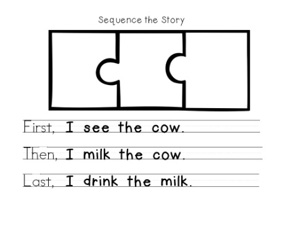 Kindergarten is such a transitional time in the life of a 5-year-old and the crucial time to begin an exciting path to lifelong learner. That being said, it is critical Kindergarten teachers fill the emergent writers with tools for the rest of their school careers. One is how to write a story in a sequence. The easiest way is with something most of you have in your classroom, sequencing puzzles. You know that kit, the one with the three puzzle pieces that obviously fit together because the pictures go together—AND there is only one way for the pieces to fit.
Kindergarten is such a transitional time in the life of a 5-year-old and the crucial time to begin an exciting path to lifelong learner. That being said, it is critical Kindergarten teachers fill the emergent writers with tools for the rest of their school careers. One is how to write a story in a sequence. The easiest way is with something most of you have in your classroom, sequencing puzzles. You know that kit, the one with the three puzzle pieces that obviously fit together because the pictures go together—AND there is only one way for the pieces to fit.
It certainly isn’t the best activity to assess or even practice their sequencing skills, but let’s not throw the puzzles away too quickly. Use that puzzle set in a center to inspire writing in a sequence.
Put a set of the puzzles together under the document camera and have the students tell the story while pointing to each picture. “I see a jar of popcorn. I cook the popcorn. I eat the popcorn.” Introduce the students to the words: first, then, and last. Ask them to restate the sentences, adding those introduction words. “First, I see a jar of popcorn. Then, I cook the popcorn. Last, I eat the popcorn.” Practice this sequencing activity with a few completed puzzles each day for a week. Each day emphasize using the words first, then, and next.
 The following week, revisit the puzzles. While the puzzles are displayed, write a sentence for each puzzle piece as a whole group. Providing a sheet with the transition words on it, students will create one story a day for a week. “First, I see the cow. Then, I milk the cow. Last, I drink the milk.” Once the students have practiced the art of orally telling a story in the correct sequence and writing the story with transition words, this becomes an independent center. I cleverly call it, “First, Then, Last.” I know it isn’t creative, but the students know exactly what to expect. I put three sets of puzzles in a resealable bag. The students choose a bag, and put the puzzles together. After they choose one puzzle they get a sequencing paper and start their independent story. This center can remain for the next several weeks or for the remainder of the school year. The same bags can be used because students choose a bag and a different puzzle to write the story. Eventually, the writing paper is replaced with word cards (first, then, last) and students can add more details to their stories as they are comfortable.
The following week, revisit the puzzles. While the puzzles are displayed, write a sentence for each puzzle piece as a whole group. Providing a sheet with the transition words on it, students will create one story a day for a week. “First, I see the cow. Then, I milk the cow. Last, I drink the milk.” Once the students have practiced the art of orally telling a story in the correct sequence and writing the story with transition words, this becomes an independent center. I cleverly call it, “First, Then, Last.” I know it isn’t creative, but the students know exactly what to expect. I put three sets of puzzles in a resealable bag. The students choose a bag, and put the puzzles together. After they choose one puzzle they get a sequencing paper and start their independent story. This center can remain for the next several weeks or for the remainder of the school year. The same bags can be used because students choose a bag and a different puzzle to write the story. Eventually, the writing paper is replaced with word cards (first, then, last) and students can add more details to their stories as they are comfortable.
Eventually, students may add a comment about how much they like or don’t like milk or even about how it would be to milk a cow. Providing simple sequencing lessons lets a student experience success with writing. Each success puts another writing tool in their toolbox and future teachers can build on this skill to increase the rigor and expectations.
 Cathy Collier is a reading specialist at Great Bridge Primary School in Chesapeake, VA, with an additional 15 years as a kindergarten teacher. She has her B.S. in Special Education, a master’s degree in Special Education and a certified reading specialist. She is the immediate past president of the Virginia State Reading Association.
Cathy Collier is a reading specialist at Great Bridge Primary School in Chesapeake, VA, with an additional 15 years as a kindergarten teacher. She has her B.S. in Special Education, a master’s degree in Special Education and a certified reading specialist. She is the immediate past president of the Virginia State Reading Association.